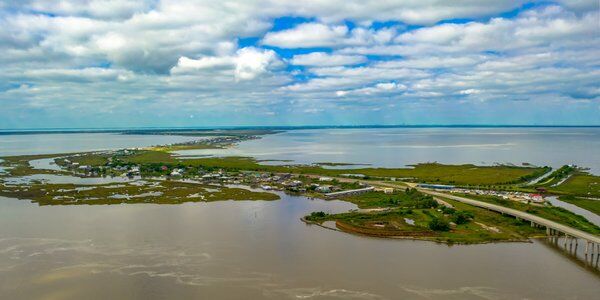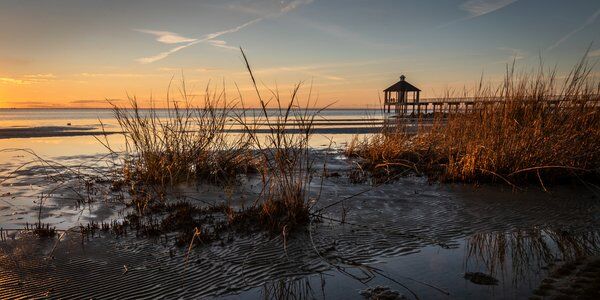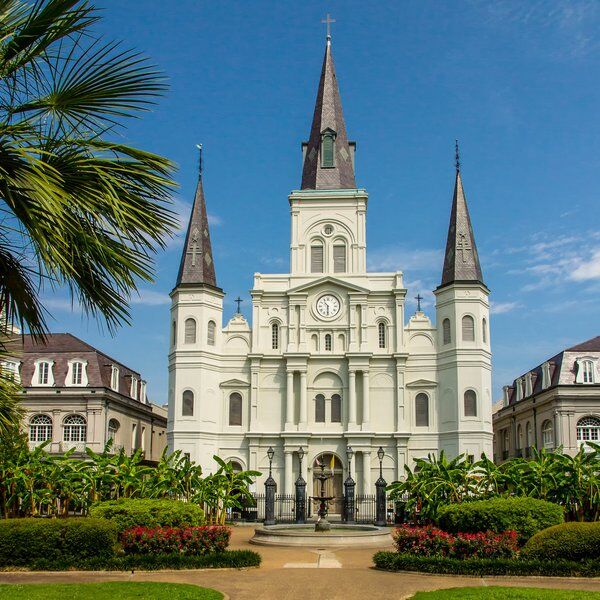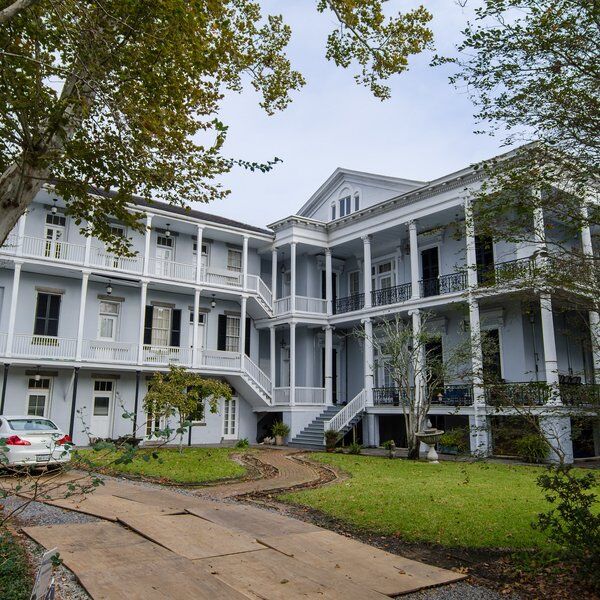
Discover Lake Pontchartrain
Lake Pontchartrain is an oval-shaped, 630 square foot estuary located in southeastern Louisiana, USA. At approximately 40 miles long, 24 miles wide, and with an average depth of 12 to 14 feet, Lake Pontchartrain is the largest inland body of water in Louisiana spilling over into 6 parishes. These include St. Tammany, New Orleans, Jefferson, St. John the Baptist, St. Charles, and Tangipahoa. The Causeway Bridge – running 23 miles over the water – is the longest bridge over water in the world and connects New Orleans to the North Shore.

The lake itself is renowned for its vibrant history, beautiful scenery, and diverse wildlife. In this article, we will take a closer look at Lake Pontchartrain's history, characteristics, and things to do in the area.
Characteristics of Lake Pontchartrain
One of the defining characteristics of Lake Pontchartrain is its brackish water. This type of water is a mix of fresh and saltwater, with the salinity varying depending on the location and time of year. Connected to the Gulf of Mexico by the ‘Rigolets Strait’, among other saltwater channels, the lake is fed with fresh water from several surrounding rivers. This mix of water is important for maintaining the lake’s diverse ecosystem; a vibrant range of plantlife, fish, birds, and other aquatic creatures.
Large populations of blue crabs, catfish, flounder, redfish, and speckled trout are popular species found within the lake (and served up in the local restaurants!) But the lake’s marshes and wetlands also provide the perfect resting and feeding habitat for several species of migratory birds, including pelicans, egrets, and herons.

The History of Lake Pontchartrain
Lake Pontchartrain was named after the home of French count Louis Phélypeaux, also known as comte de Pontchartrain, who was a significant Minister, Chancellor, and Controller-General of Finances during the reign of Louis XIV, for which Louisiana was named. Having been formed between 2,600 and 4,000 years ago, Lake Pontchartrain has proven itself as a vital resource for the city of New Orleans.
Native American Origins
As far back as 3,500 years ago, Lake Pontchartrain was inhabited by Native American tribes, who referred to the lake as Okwata ('wide water') and used it primarily as a food and water source. The water was teeming with a wide range of fish including catfish, drum, and redfish – all of which were an essential part of the Native American diet.
European Settlement
In 1699, French explorer Pierre Le Moyne d'Iberville arrived in the area and established a settlement along the banks of the Mississippi River. From here, human habitation of Lake Pontchartrain increased rapidly. The French colonists recognized the importance of Lake Pontchartrain as a transportation hub for trade and commerce. After the establishment of several forts along the shoreline the lake also played an essential role in the city’s defense during many important battles, such as the Battle of New Orleans in 1815.
Hurricane Katrina
Throughout its history, Lake Pontchartrain has experienced many hurricanes. As a result, along Lake Pontchartrain’s southern shore, hurricane-protection levees were constructed to protect the communities of New Orleans.
In 2005, Hurricane Katrina devastated Lake Pontchartrain. During the storm surging winds pushed water up the Gulf of Mexico and into the lake. This caused widespread flooding and destruction, and many of New Orleans’ levees were damaged.
The hurricane highlighted the vulnerability of the lake and the ecosystems’ need for protection. Consequently, efforts were made to strengthen New Orleans’ levee system, which was found to be faulty and inadequately built in places, and improve its overall infrastructure as a preventative measure against future storms.

The Impact of Hurricanes
The hurricanes and storms that have ravaged Lake Pontchartrain over the years have had significant environmental, economic, and social impacts on the lake and its surrounding areas. Here are some ways in which Lake Pontchartrain has been affected by hurricanes:
Damage to Infrastructure
Roads, bridges, and buildings have sustained damage as a consequence of hurricane flooding and high winds in the area. This damage can lead to the displacement of people and businesses, resulting in economic hardship for the surrounding communities.
Erosion and Loss of Wildlife
Storm surges and high winds caused by hurricanes have caused significant erosion along the shore of Lake Pontchartrain. Erosion disrupts the lake’s natural ecosystem by causing damage to the vegetation. The resulting loss of habitat can have long-term impacts on the biodiversity of the lake and the surrounding areas.
Water Quality
Heavy rainfall and storm surges can result in the displacement of sediment, debris, and pollutants into the lake. These pollutants can have detrimental effects on the lake’s ecosystem and threaten the health of wildlife and humans.

Conservation Efforts
Clearly, hurricanes in Louisiana have placed Lake Pontchartrain’s ecosystems under great duress. Marshlands began receding, transforming into areas of open water; and the forest and swamps suffocated from forced saltwater intrusion coupled with a lack of freshwater, which was inhibited by the upstream levees. However, there have been multiple conservation efforts to address these (and other) issues and protect the lake’s ecosystem.
Water Quality Monitoring
One of the chief conservation efforts at Lake Pontchartrain is water quality monitoring. Monitoring the water quality is critical to understanding the state of the lake’s ecosystem and identifying any potential threats. Regular water sampling and testing are conducted by various organisations, including the Pontchartrain Conservancy (PC) and Lake Pontchartrain Basin Foundation (LPBF). This data is used to create strategies that will preserve, protect, and restore areas of the lake’s ecosystem like the forests and cypress swamps.
Restoration Projects
As part of the restoration efforts, one project is geared towards restoring the wetlands and marshes along the lake’s edge, which serve as a buffer against storm surges and provide habitat for wildlife. The LPBF has implemented several multi-million dollar wetland restoration projects, including the creation of the Bayou Bonfouca Marsh Living Shoreline and the Bayou Lacombe Oyster Reef.
Education and Outreach
Education and outreach programmes have become a vital aspect of conservation efforts concerning Lake Pontchartrain. The LPBF has also created educational tours, workshops, and community events. The overall intention is to increase awareness and understanding of the importance of protecting and preserving the lake’s natural and diverse habitats.
Reducing Pollution
Pollution is a significant threat to the lake’s ecosystem. The implementation of stormwater management strategies however, reduces the amount of pollutants that enter the lake during heavy rains. The PC has also established the Pontchartrain Estuary Program, reducing pollution by focusing on best management practices for agriculture and urban land use.
Despite the challenges presented by hurricanes and other natural disasters, the lake remains a vital resource for the city, providing food, and recreational opportunities for residents and visitors alike. It also continues to be an important part of the city's culture and identity, serving as a testament to the resilience and determination of the people of New Orleans.
Things to do at Lake Pontchartrain
There is a wide range of activities on offer for visitors at Lake Pontchartrain. One of the most popular things to do is take a scenic 50-minute drive across the Lake Pontchartrain Causeway Bridge. But there are also fishing opportunities, bike rentals, beaches, and lots of restaurants to indulge your taste buds in!
For more cultural pursuits, visitors could go to the New Canal Lighthouse Museum, which was originally built in 1850. Following its restoration after Hurricane Katrina, visitors can discover the history of the lakes, the ecology of the Pontchartrain basin, and any environmental issues it faces in today’s climate.

Fishing and Boating along Lake Pontchartrain
The brackish quality of the water makes Lake Pontchartrain ideal for fishing, with the lake playing host to several tournaments throughout the year. There are also plenty of ways for visiting or local boating families and friends to access the water, including marinas and boat launchers, adding to the lake’s appeal.
The Sugar Bowl Regatta is a sailing competition held from November to New Year's Eve each year since 1934 (not including during 1939-1945 and the year following Hurricane Katrina). For those not participating, kicking back and chilling along the shoreline to watch them race by, is a popular local pastime.
Biking Trails around Lake Pontchartrain
After recent upgrades around Lakeshore Drive, the area has become good for bike riding and walking. Many of the restaurants also offer bike parking as well, meaning cyclists can take regular pit stops along their journey.
Parks and Beaches at Lake Pontchartrain
For those looking for a more leisurely activity, there are several parks and recreational areas around the lake. One of the most popular is Fontainebleau State Park, where visitors can camp, hike, and fish. There are also several public beaches, including Northshore Beach and Pontchartrain Beach, which is a popular spot for swimming and sunbathing.
Restaurants
Looking for a bite to eat? Look no further than the family-friendly spattering of local eateries brimming with everything from fresh seafood and wood-fired pizzas, to ice creams and other sweet treats. Or pack a picnic, and then its possible to continue relaxing by the lake until well into the evening!
Our Thoughts…
Playing an essential role in the history of New Orleans, from early Native American settlement to today’s society, Lake Pontchartrain is a cultural landmark and haven for wildlife. Visitors to the lake will relish in everything it has to offer, from fishing and boating, to sunbathing and swimming… not to mention eating! A trip to its shores is a must, for anyone passing through New Orleans!















